It looks like you're using an Ad Blocker.
Please white-list or disable AboveTopSecret.com in your ad-blocking tool.
Thank you.
Some features of ATS will be disabled while you continue to use an ad-blocker.
share:
A New Preonic Model for the Composition of All Known Matter and Energy
by John SkieSwanne
~
I am one of those who firmly believe there exists something smaller than quarks, leptons and even gauge bosons. That preons do exist. I reviewed many preonic models, but none of them satisfied my investigations, as they rendered the Standard Model even more busier. Like Reductionism, I think it is necessary to assume that there should be less preon types than quarks (for the laymen: there should be less types of bricks than the types of walls which these bricks build - it's useless to have hundred of brick shapes if you just need the rectangular ones to built a standard wall).
After years of investigations I finally came up with a preonic model of my own, which (at least partially) unifies gauge bosons with leptons and quarks. This model involves only 2 types of preons. I came to call these "a" preons and "b" preons.
My model is remarkable on the fact that it predicts exactly how energy particles can be converted into matter (which reminds me loosely of those sci-fi materializers). And it is remarkable on the fact that it sheds a bit of a controversial light on the W bosons.
~
I suggest that all currently known particles, including quanta, are made of smaller components, preons. More specifically, of 6 preons. A stable particle may not have more, nor less, than 6 preons. Preons come in two flavours. The "a" preon has an electric charge of +1/6. The "b" preon has an electric charge of -1/6. Each particle has an antiparticle whose sequence is the exact opposite - a bit like the negative of an image.
Up quarks are made of 5 "a" preons and 1 "b" preon. Up antiquarks are made of the exact opposite: 1 "a" preons and 5 "b" preons.
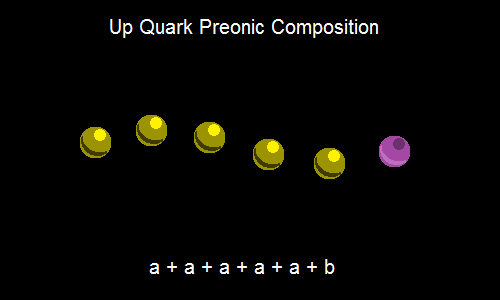
Down quarks are made of 2 "a" preons and 4 "b" preons. Their antiparticles are made of the exact opposite: 4 "a" preons and 2 "b" preons.
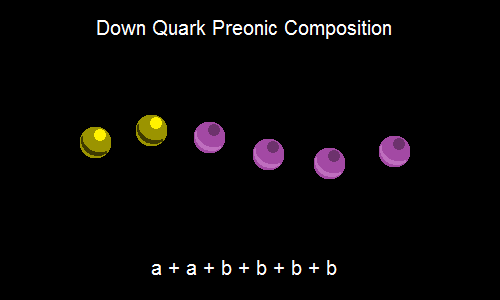
Electrons are made of "b" preons exclusively, giving them a charge of -6/6 (-1). Positrons are made of the exact opposite: 6 "a" preons, giving them a charge of +6/6 (+1).
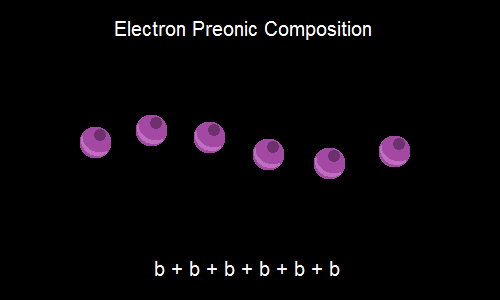
And neutrinos are made of equal quantities of "a" and "b" preons.

Gauge bosons are also made of equal quantities of "a" and "b" preons:

(the observed mass difference between neutrinos and gauge bosons may perhaps reside in the sequence of the preons inside the particles, for instance "abaabb" instead of "aaabbb")
~
Bearing that in mind, explaining particles decay is quite simpler and elegant.
Let's first explore electron/positron annihilation. According to the preonic model, this event actually occurs when the electron gives 3 "b" preons to the positron, and the positron gives 3 "a" preons to the electron. The result is in agreement with experimentation, which is the conversion into two gauge bosons (here photons).
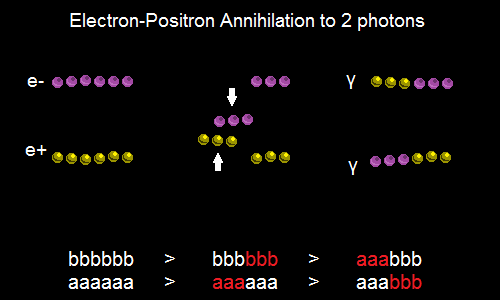
And let's explore the proton decay by electron capture. Again, nothing more than an exchange of preons. The capture of the electron causes the up quark in a proton to give 3 "a" preons to the electron, which gives in return 3 of its "b" preon. The result is the conversion of the up quark to a down quark, and the conversion of the electron into an electron neutrino:

~
So, so far everything agrees with the preonic model. Now when it comes to the neutron's natural decay, things get really interesting. My suggestion implies that the environment's level of energy (carried by gauge bosons) actually triggers the neutron's decay. Meaning, it makes the interesting prediction that in total darkness, in total isolation from any other forces, and at 0 degrees K, neutrons could actually live longer than one quarter of an hour.
Mainstream explanation for the neutron's beta decay involves a virtual particle, known as the W- boson. According to mainstream, the neutron is stable for 885.7 seconds. Then, the transforming down quark emits a W- boson as it changes to an up quark. Then, very shortly after (about 3x10-25 second), this W- boson splits into two new particles: an electron and an antineutrino.
A diagram to show what is believed to happen:
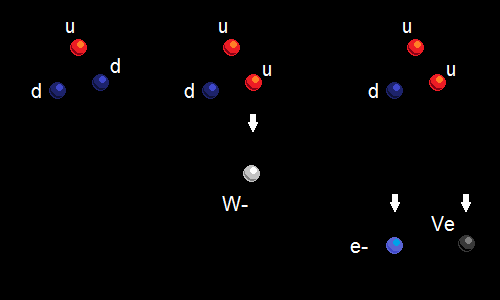
A common question which physicist often have to answer is why particles seem to multiply and even gain mass as the beta decay occurs. First, the down gives birth to the super-massive W- boson. Then the W- boson decays into yet another pair of particles.
But my preonic model implies that no intermediate W- bosons are needed for the neutron to decay into a proton, an electron and an antineutrino. The shuffling of preons and the presence of a background energy quanta (Thermal? Quantum jitter? or maybe even graviton?) already account for these transformations:
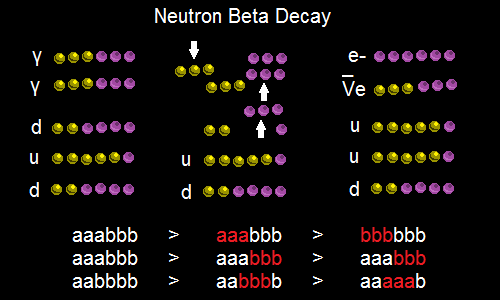
Here we see a background gauge boson (here a thermal radiation quanta) giving 3 "a" preon to the down quark, which forces the other gauge boson to yield its 3 "b" preons to the first boson, and finally the down quark give 3 "b" preons to the second gauge boson. Once this shuffling is done, the result is a down quark, an antineutrino and an electron.
This suspected interaction with environmental energy is confirmed by the proton's decay. As you well know, protons live almost forever, except in high-energy background. For instance, in nucleons. This is predicted by my model. In an low-energy environment, the proton doesn't have enough "partners" with which exchange preons. But in higher energy environments, the energy itself actually helps the proton to decay into a neutron, a positron and a neutrino (called the inverse beta decay):
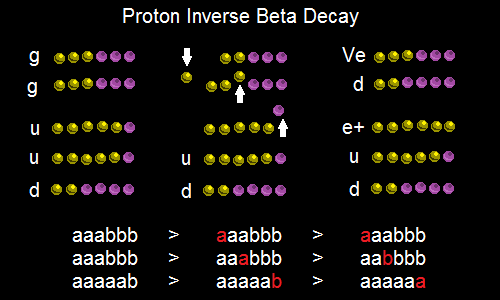
In such conditions, a gauge boson (here assumed to be a gluon, since nucleon's binding energy is provided by only one known force, the Strong interaction force) gives 1 "a" preon to the up quark. The other gives 1 "a" preon to the first gauge boson. The up quark, like any particles, can't have more or less than 6 preon, so it gives up its lone "b" preon to the second gauge boson. This quick shuffling solves the mystery.
~
I know further refining is needed for the theory to be more accurate. It's really just a rough idea, far from being perfect. For instance, I didn't came up with something to predict the transformations of mass yet, just of the electric charges. So I still miss a great deal of prediction accuracy. For instance, my model incorrectly predicts that charged pion decay will result in first-generation leptons emission, when in truth it results in second-generation leptons emission. I would in fact greatly appreciate any suggestions or insights as to how to solve this mystery. I feel hopeful that QCD will have the capacity to provide the missing link. Please bear in mind I am not a physicist though, physics is just a hobby, so I would plead you to go with the laymen terms (well, in the limit of the possible, of course) please.
So, this is it. From common antimatter annihilation to rare proton decay, one can still predict these transformations by classifying all matter and energy as particles each made of 6 preons, which come in only 2 kinds. A bit like DNA, it's the sequence ("aabbbb" for down quark, "bbbbbb" for electron, etc.) that mostly determines what the particle's identity will be.
This pretty much concludes my short suggestion regarding preonic composition of known matter and energy particles.
Food for thoughts.
~
At Time's End,
Swan
by John SkieSwanne
~
I am one of those who firmly believe there exists something smaller than quarks, leptons and even gauge bosons. That preons do exist. I reviewed many preonic models, but none of them satisfied my investigations, as they rendered the Standard Model even more busier. Like Reductionism, I think it is necessary to assume that there should be less preon types than quarks (for the laymen: there should be less types of bricks than the types of walls which these bricks build - it's useless to have hundred of brick shapes if you just need the rectangular ones to built a standard wall).
After years of investigations I finally came up with a preonic model of my own, which (at least partially) unifies gauge bosons with leptons and quarks. This model involves only 2 types of preons. I came to call these "a" preons and "b" preons.
My model is remarkable on the fact that it predicts exactly how energy particles can be converted into matter (which reminds me loosely of those sci-fi materializers). And it is remarkable on the fact that it sheds a bit of a controversial light on the W bosons.
~
I suggest that all currently known particles, including quanta, are made of smaller components, preons. More specifically, of 6 preons. A stable particle may not have more, nor less, than 6 preons. Preons come in two flavours. The "a" preon has an electric charge of +1/6. The "b" preon has an electric charge of -1/6. Each particle has an antiparticle whose sequence is the exact opposite - a bit like the negative of an image.
Up quarks are made of 5 "a" preons and 1 "b" preon. Up antiquarks are made of the exact opposite: 1 "a" preons and 5 "b" preons.

Down quarks are made of 2 "a" preons and 4 "b" preons. Their antiparticles are made of the exact opposite: 4 "a" preons and 2 "b" preons.

Electrons are made of "b" preons exclusively, giving them a charge of -6/6 (-1). Positrons are made of the exact opposite: 6 "a" preons, giving them a charge of +6/6 (+1).

And neutrinos are made of equal quantities of "a" and "b" preons.

Gauge bosons are also made of equal quantities of "a" and "b" preons:

(the observed mass difference between neutrinos and gauge bosons may perhaps reside in the sequence of the preons inside the particles, for instance "abaabb" instead of "aaabbb")
~
Bearing that in mind, explaining particles decay is quite simpler and elegant.
Let's first explore electron/positron annihilation. According to the preonic model, this event actually occurs when the electron gives 3 "b" preons to the positron, and the positron gives 3 "a" preons to the electron. The result is in agreement with experimentation, which is the conversion into two gauge bosons (here photons).

And let's explore the proton decay by electron capture. Again, nothing more than an exchange of preons. The capture of the electron causes the up quark in a proton to give 3 "a" preons to the electron, which gives in return 3 of its "b" preon. The result is the conversion of the up quark to a down quark, and the conversion of the electron into an electron neutrino:

~
So, so far everything agrees with the preonic model. Now when it comes to the neutron's natural decay, things get really interesting. My suggestion implies that the environment's level of energy (carried by gauge bosons) actually triggers the neutron's decay. Meaning, it makes the interesting prediction that in total darkness, in total isolation from any other forces, and at 0 degrees K, neutrons could actually live longer than one quarter of an hour.
Mainstream explanation for the neutron's beta decay involves a virtual particle, known as the W- boson. According to mainstream, the neutron is stable for 885.7 seconds. Then, the transforming down quark emits a W- boson as it changes to an up quark. Then, very shortly after (about 3x10-25 second), this W- boson splits into two new particles: an electron and an antineutrino.
A diagram to show what is believed to happen:

A common question which physicist often have to answer is why particles seem to multiply and even gain mass as the beta decay occurs. First, the down gives birth to the super-massive W- boson. Then the W- boson decays into yet another pair of particles.
But my preonic model implies that no intermediate W- bosons are needed for the neutron to decay into a proton, an electron and an antineutrino. The shuffling of preons and the presence of a background energy quanta (Thermal? Quantum jitter? or maybe even graviton?) already account for these transformations:

Here we see a background gauge boson (here a thermal radiation quanta) giving 3 "a" preon to the down quark, which forces the other gauge boson to yield its 3 "b" preons to the first boson, and finally the down quark give 3 "b" preons to the second gauge boson. Once this shuffling is done, the result is a down quark, an antineutrino and an electron.
This suspected interaction with environmental energy is confirmed by the proton's decay. As you well know, protons live almost forever, except in high-energy background. For instance, in nucleons. This is predicted by my model. In an low-energy environment, the proton doesn't have enough "partners" with which exchange preons. But in higher energy environments, the energy itself actually helps the proton to decay into a neutron, a positron and a neutrino (called the inverse beta decay):

In such conditions, a gauge boson (here assumed to be a gluon, since nucleon's binding energy is provided by only one known force, the Strong interaction force) gives 1 "a" preon to the up quark. The other gives 1 "a" preon to the first gauge boson. The up quark, like any particles, can't have more or less than 6 preon, so it gives up its lone "b" preon to the second gauge boson. This quick shuffling solves the mystery.
~
I know further refining is needed for the theory to be more accurate. It's really just a rough idea, far from being perfect. For instance, I didn't came up with something to predict the transformations of mass yet, just of the electric charges. So I still miss a great deal of prediction accuracy. For instance, my model incorrectly predicts that charged pion decay will result in first-generation leptons emission, when in truth it results in second-generation leptons emission. I would in fact greatly appreciate any suggestions or insights as to how to solve this mystery. I feel hopeful that QCD will have the capacity to provide the missing link. Please bear in mind I am not a physicist though, physics is just a hobby, so I would plead you to go with the laymen terms (well, in the limit of the possible, of course) please.
So, this is it. From common antimatter annihilation to rare proton decay, one can still predict these transformations by classifying all matter and energy as particles each made of 6 preons, which come in only 2 kinds. A bit like DNA, it's the sequence ("aabbbb" for down quark, "bbbbbb" for electron, etc.) that mostly determines what the particle's identity will be.
This pretty much concludes my short suggestion regarding preonic composition of known matter and energy particles.
Food for thoughts.
~
At Time's End,
Swan
reply to post by swanne
The first question that enters my mind when seeing any new hypothesis is, can it be tested, or verified by experiment or observation, and if so, how?
The first question that enters my mind when seeing any new hypothesis is, can it be tested, or verified by experiment or observation, and if so, how?
Originally posted by Arbitrageur
reply to post by swanne
The first question that enters my mind when seeing any new hypothesis is, can it be tested, or verified by experiment or observation, and if so, how?
Well it is unlikely we will have the tech to see inside quarks using current methods. I mean, it's already hard to separate two quarks, imagine how much work it'll take separating preons.
But I think it may be possible to test some of its particle decay-related implications. For instance, since my suggestion implies neutrons will decay slower if isolated from other particles including gauge bosons, it might be possible to test that.
edit on 9-9-2013 by swanne because: (no reason given)
But why? Are you also hypothesizing some new force that holds preons together?
Originally posted by swanne
Well it is unlikely we will have the tech to see inside quarks using current methods. I mean, it's already hard to separate two quarks, imagine how much work it'll take separating preons.
I don't really follow that. A free neutron has a mean lifetime of about 15 minutes. But neutrons inside nuclei can be stable, like in many elements with atomic numbers 2-40.
But I think it may be possible to test some of its particle decay-related implications. For instance, since my suggestion implies neutrons will decay slower if isolated from other particles including gauge bosons, it might be possible to test that.
So are you saying observations contradict predictions of your model?
Originally posted by Arbitrageur
A free neutron has a mean lifetime of about 15 minutes. But neutrons inside nuclei can be stable, like in many elements with atomic numbers 2-40.
This is a very good point, thanks for bringing it up to my attention. Hm, it does allow a great level of mystery. On the other hand, protons, which also tend to last forever, decay faster inside the nucleon - which actually goes in-step with my model. But then I must ask... How do conventional theories explains this? I assume the standard model does have an explanation. Maybe their explanation can be applied here to solve the mystery.
edit on 9-9-2013 by swanne because: (no reason given)
But why? Are you also hypothesizing some new force that holds preons together?
Why preons would be harder to separate than quarks? Hm, I would think that the force that binds them is greater than color force.
There are two candidates in my layman mind for the force that binds preons together:
-Wavefunction,
-fifth dimension.
In the case of wavefunction: since electrons too are made of preons, And electrons do follow wavefunction's prediction, I think it might be possible that quarks too could be thought of as wavefunctions. Meaning, preons inside a quark would be bound there as a probability wave, and their escape from there could be thought of as a variant of quantum tunnelling. Since gauge bosons are too wavefunction quanta, their energy would expand the wavefunction of another particle (phase effect?), and allow this other particle to exchange preons and decay. I don't consider this possibility very likely, but it's a possibility.
In the case of dimension: since a flat cube can look like a square (see Susskind's string theory), it may be possible that preons are trapped inside a fifth dimension, but as this dimension is tightly wrapped, to us us it looks as if they are bound together. Just like a 2-D cylinder looks like a string from far away. But note that this possibility doesn't give a mechanism through which preons can actually escape the brane and interact with those in another particle.
edit on 9-9-2013 by swanne because: (no reason given)
Any preon theory needs to be consistent with how preons were described with a yogic siddhi called "anima" over a century ago.
smphillips.8m.com...
This not only described up and down quarks, as proved beyond question by self-consistent analysis of the paranormal descriptions of the atomic nuclei of over 40 elements, but also their preon constituents. Analysis deduced the following composition of up and down quarks:
u = X-X-Y, d = X-Y-Y
where X is a spin-1/2 fermion with a positive electric charge of +5/9 and Y is a spin-1/2 fermion with a negative electric charge of -4/9.
This of course disagrees with the OP's model, which is inconsistent with the known spins of up and down quarks and the Pauli Exclusion Principle. The reason for this is as follows: if:
u = a-a-a-a-a-b,
d = a-a-b-b-b-b,
then if, a has spin-1/2, then b must have spin 0 and an odd number of a's can create a u with spin 1/2, but this means that d with an even number of a's has spin 0 or spin 1, which is false. Therefore, a must have spin 0 and b must have spin 1/2. But then, as d comprises an even number of b's, the predicted spin of d is an even integer, which is incorrect. Therefore, the OP's preon model is false because it predicts the wrong spin for up and down quarks.
smphillips.8m.com...
This not only described up and down quarks, as proved beyond question by self-consistent analysis of the paranormal descriptions of the atomic nuclei of over 40 elements, but also their preon constituents. Analysis deduced the following composition of up and down quarks:
u = X-X-Y, d = X-Y-Y
where X is a spin-1/2 fermion with a positive electric charge of +5/9 and Y is a spin-1/2 fermion with a negative electric charge of -4/9.
This of course disagrees with the OP's model, which is inconsistent with the known spins of up and down quarks and the Pauli Exclusion Principle. The reason for this is as follows: if:
u = a-a-a-a-a-b,
d = a-a-b-b-b-b,
then if, a has spin-1/2, then b must have spin 0 and an odd number of a's can create a u with spin 1/2, but this means that d with an even number of a's has spin 0 or spin 1, which is false. Therefore, a must have spin 0 and b must have spin 1/2. But then, as d comprises an even number of b's, the predicted spin of d is an even integer, which is incorrect. Therefore, the OP's preon model is false because it predicts the wrong spin for up and down quarks.
Originally posted by micpsi
Any preon theory needs to be consistent with how preons were described with a yogic siddhi called "anima" over a century ago.
(*sigh*) This is not a metaphysical forum. Please post this in the appropriate forum. Yoga is not the current topic.
This of course disagrees with the OP's model, which is inconsistent with the known spins of up and down quarks
That's because my "a" and "b" preons don't have a spin of 1/2 - they have a electric CHARGE signs of one sixths. Of course your computation will go wrong if you assume they have 6 half-spins.
I didn't assigned spins to the preons yet, mainly because I'm not sure they have one. Look at the difference between a neutrino (non-integer spin) and a gauge boson (integer spin). Do you see a difference? No. which means, the spin is not a property of the preon themselves, but of of another variable which needs to be investigated.
edit on 9-9-2013 by swanne because: (no reason given)
reply to post by swanne
The most simple explanation I've heard for neutron stability is energy conservation. Take a deuteron as example, proton + neutron nucleus has less total energy than proton + proton + electron + anti-neutrino.
The most simple explanation I've heard for neutron stability is energy conservation. Take a deuteron as example, proton + neutron nucleus has less total energy than proton + proton + electron + anti-neutrino.
Originally posted by moebius
reply to post by swanne
The most simple explanation I've heard for neutron stability is energy conservation. Take a deuteron as example, proton + neutron nucleus has less total energy than proton + proton + electron + anti-neutrino.
Hm, I would agree with you (and stared you, because this is a very important point to remember), but here the example is anomalistic:
p+ + n0 = 938 + 939 = 1977
p+ + p+ + e- + Ve = 1976.5
Maybe some KE is involved??
reply to post by swanne
You are missing the (negative) binding energy between proton and neutron in the nucleus.
You are missing the (negative) binding energy between proton and neutron in the nucleus.
Originally posted by moebius
You are missing the (negative) binding energy between proton and neutron in the nucleus.
Right. Thanks! Okay, now it adds up.
To my knowledge proton decay is an unsolved problem in physics, I think because some models predict proton decay, but it hasn't been observed.
Originally posted by swanne
This is a very good point, thanks for bringing it up to my attention. Hm, it does allow a great level of mystery. On the other hand, protons, which also tend to last forever, decay faster inside the nucleon - which actually goes in-step with my model. But then I must ask... How do conventional theories explains this? I assume the standard model does have an explanation.
I don't know where you got this information about protons tending to decay faster inside the nucleon. Have you got a source for that?
Neutron decay on the other hand has been observed, and I think it's predicted by the standard model as a result of electro-weak interaction. Here's a paper that talks about measurement of neutron decay and verification of the standard model:
nvlpubs.nist.gov...
I'm perplexed why some 'particles' have identical preon arrangements.
swanne
Originally posted by micpsi
Any preon theory needs to be consistent with how preons were described with a yogic siddhi called "anima" over a century ago.
(*sigh*) This is not a metaphysical forum. Please post this in the appropriate forum. Yoga is not the current topic.
As this is not as of yet physics 'proper', metaphysics may contain some relevance, as 'meta' used as a prefix means 'beyond', no?
I know not of what micpsi mentions, but any relevance is worth investigation if not for the sole purpose of elimination.
Arbitrageur
I don't know where you got this information about protons tending to decay faster inside the nucleon. Have you got a source for that?
Sure, here it goes.
However, inside a nucleus, protons can also transform into a neutron via inverse beta decay. This transformation occurs by emission of an antielectron (also called positron) and an electron neutrino
(...)
protons, which are stable in empty space, may transform into neutrons when bound inside of a nucleus.
Source: en.wikipedia.org...
abecedarian
I'm perplexed why some 'particles' have identical preon arrangements.
Indeed. Here you see two particles having the same arrangements - the neutrino and the gauge boson. I too am perplexed about this feature, but not surprised. Both have very low mass and are neutrally charged. That's why I think these two properties are related to the arrangement (the "sequence") of the preons. The same should go for the spin too. I don't know, maybe "aababb" gives particles with spin=2, and "aaabbb" gives particles with spin=1/2. Like DNA sequence, the end result depends on the sequence.
I have been working on a symbolic chemistry model which uses "charge glyphs" as the functional elements. your model reminded me that a month
ago-ish I started assigning numerical values to the charges arbitrarily and found that many of my molecular representations had a charge symmetries in
(multiples of) 6.
I won't go into anymore detail, but I am gonna try to apply some of your transformations to my work and see if anything interesting falls out.
neat model.
I won't go into anymore detail, but I am gonna try to apply some of your transformations to my work and see if anything interesting falls out.
neat model.
reply to post by swanne

I hope that you do not find it insulting for me to inject a certain mysticism into your thread. I am always intrigued by intersections of esoterics and science.
the above familiar word is said to be the word that "speaks" reality into existence. it is also (tho not in this pic) the root of 'abraham'. built of two basic elements, (abra) and (cad). make of it what you will.....

I hope that you do not find it insulting for me to inject a certain mysticism into your thread. I am always intrigued by intersections of esoterics and science.
the above familiar word is said to be the word that "speaks" reality into existence. it is also (tho not in this pic) the root of 'abraham'. built of two basic elements, (abra) and (cad). make of it what you will.....
So in other words you've discovered that you can write any number as a sum of fractions. Yes, yes, you can. That's not physics, though, even if that
number happens to be electric charge.
Aside from the fact that you'd have to use, you know, actual math beyond what you learned in kindergarten to do real physics, you'd have to explain, e.g., how confinement works, spin, weak isospin, lots of other quantum numbers, calculate interaction cross sections, explain why this works even though the quark has been observed to have no signs of internal structure, how this is compatible with the group theoretic structure of particle physics, etc.
What you have now is just counting that flagrantly violates pretty much all observations about how particles work.
Aside from the fact that you'd have to use, you know, actual math beyond what you learned in kindergarten to do real physics, you'd have to explain, e.g., how confinement works, spin, weak isospin, lots of other quantum numbers, calculate interaction cross sections, explain why this works even though the quark has been observed to have no signs of internal structure, how this is compatible with the group theoretic structure of particle physics, etc.
What you have now is just counting that flagrantly violates pretty much all observations about how particles work.
new topics
-
The Great Reckoning
Rant: 4 hours ago -
The Inconvenient Bellwether County Dilemma
Education and Media: 5 hours ago -
Elite Universities Are Coddling Students Grieving Over Trump's Victory
Mainstream News: 5 hours ago -
Witnesses who will testify in next week's hearing on UAPs
Aliens and UFOs: 5 hours ago -
Qatar kicks out HAMAS
Middle East Issues: 5 hours ago -
leftwing wymen shaving their head in protest
US Political Madness: 8 hours ago -
Racist Text Messages Mass Distributed
Social Issues and Civil Unrest: 8 hours ago -
No, the election results aren't reminiscent of 1930s Germany. But this is.
US Political Madness: 9 hours ago -
Agree or Disagree
2024 Elections: 10 hours ago
top topics
-
The Inconvenient Bellwether County Dilemma
Education and Media: 5 hours ago, 27 flags -
The Great Reckoning
Rant: 4 hours ago, 16 flags -
Leaving the US due to severe TDS?
US Political Madness: 12 hours ago, 14 flags -
No, the election results aren't reminiscent of 1930s Germany. But this is.
US Political Madness: 9 hours ago, 14 flags -
Qatar kicks out HAMAS
Middle East Issues: 5 hours ago, 12 flags -
Elite Universities Are Coddling Students Grieving Over Trump's Victory
Mainstream News: 5 hours ago, 11 flags -
leftwing wymen shaving their head in protest
US Political Madness: 8 hours ago, 10 flags -
Agree or Disagree
2024 Elections: 10 hours ago, 7 flags -
Witnesses who will testify in next week's hearing on UAPs
Aliens and UFOs: 5 hours ago, 6 flags -
Racist Text Messages Mass Distributed
Social Issues and Civil Unrest: 8 hours ago, 4 flags
active topics
-
Where ARE the 20 million votes??? Where ARE they????? WHERE???
US Political Madness • 51 • : CarlLaFong -
leftwing wymen shaving their head in protest
US Political Madness • 68 • : BingoMcGoof -
Racist Text Messages Mass Distributed
Social Issues and Civil Unrest • 19 • : MetalThunder -
President-Elect DONALD TRUMP's 2nd-Term Administration Takes Shape.
Political Ideology • 58 • : fringeofthefringe -
Agree or Disagree
2024 Elections • 18 • : BingoMcGoof -
DOJ moving to wind down Trump criminal cases before he takes office
Mainstream News • 40 • : UKTruth -
The Great Reckoning
Rant • 15 • : Flyingclaydisk -
The Inconvenient Bellwether County Dilemma
Education and Media • 6 • : putnam6 -
Liberal women going on sex strike over Trump win
US Political Madness • 62 • : matafuchs -
Qatar kicks out HAMAS
Middle East Issues • 9 • : marg6043
